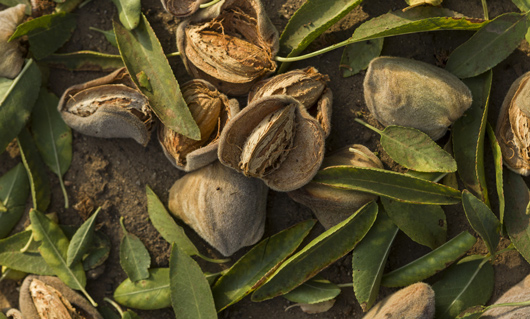Can almond coproducts help keep troublesome pests out of almond orchards? New research from University of California, Davis, suggests almond biomass can play a key role in pest management.
As part of a research initiative funded by Almond Board of California’s Almond Biomass Working Group, UC Davis researchers sought to determine if almond hulls and shells were compatible with biosolarization technology.
“Biosolarization uses natural mechanisms to create soil conditions lethal to pests,” said Christopher Simmons, PhD, UC Davis, who conducted the research trials. “By combining heat from the sun and natural biopesticides promoted by organic matter from hulls and shells, we can eliminate pests in the soil.” 
The research comes as almond production continues to climb, yet traditional outlets for hulls, shells and woody biomass are less. Recent market shifts are forcing changes to traditional uses and spurring new interest in the highest value use of each almond coproduct.
The biomass project got its start in December 2016 when UC Davis researchers discussed their approach with Almond Board of California and Nicolaus Nut Company (a fallow orchard owned by Nicolaus Nut Company was proposed as a field trial site). After a feasibility study at UC Davis labs in the spring, field trials began in July 2017.
“The fallow orchard, which was slated for transition to almonds from walnuts, was heavily infested with nematodes,” said Simmons. “It provided optimum conditions to test the effectiveness of almond biomass biosolarization.”
Researchers began in the field by amending almond biomass into the soil, laying a drip line on top of the soil and covering the orchard floor with a clear plastic tarp. Following this setup and then irrigating through the drip line, they created a greenhouse heating effect that helped elevate the temperature of the soil. Additionally, bacteria in the soil consumed the almond matter amended in the soil. This microbial activity—in the anaerobic environment created by the tarp covering—led to the accumulation of natural organic acids toxic to certain pests.
Simmons and his colleagues discussed their biosolarization research findings in depth at 2017 The Almond Conference. They also previewed implications for future crop growth and orchard impact, as the biosolarization site was to be planted with almond trees early in the 2018 season.
“Beyond pest management, keeping almond biomass in the orchard can deliver additional benefits,” said Simmons. “You’re putting all this organic matter back into the soil, which will help improve fertility, water holding capacity and microbial diversity of the soil.”
To learn more about this research, review the presentation, titled “Almond Biomass: The Real, Weird and Wonderful Opportunities for Greater Utilization,” at Almonds.com/ConferencePresentations. To register for future Almond Conferences, visit AlmondConference.com/Register.aspx.